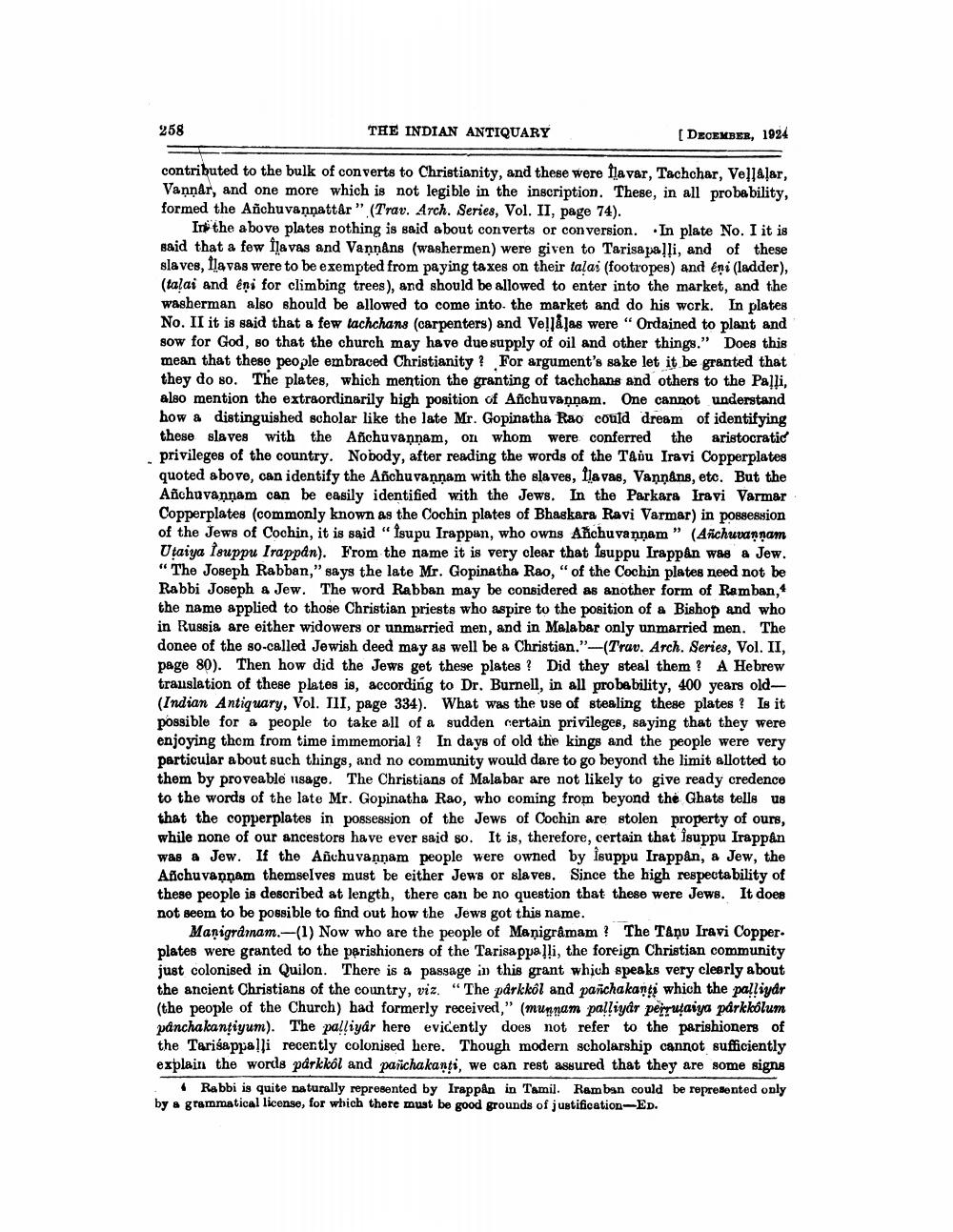________________
THE INDIAN ANTIQUARY
[DECEMBER, 1924
contributed to the bulk of converts to Christianity, and these were flavar, Tachchar, Vellalar, Vannar, and one more which is not legible in the inscription. These, in all probability, formed the Añchuvannattâr" (Trav. Arch. Series, Vol. II, page 74).
In the above plates nothing is said about converts or conversion. In plate No. I it is said that a few flavas and Vannans (washermen) were given to Tarisapalli, and of these slaves, Ilavas were to be exempted from paying taxes on their talai (footropes) and eni (ladder), (talai and êni for climbing trees), and should be allowed to enter into the market, and the washerman also should be allowed to come into the market and do his work. In plates No. II it is said that a few tachchans (carpenters) and Vellalas were "Ordained to plant and sow for God, so that the church may have due supply of oil and other things." Does this mean that these people embraced Christianity? For argument's sake let it be granted that they do so. The plates, which mention the granting of tachchans and others to the Palli, also mention the extraordinarily high position of Añchuvannam. One cannot understand how a distinguished scholar like the late Mr. Gopinatha Rao could dream of identifying these slaves with the Añchuvannam, on whom were conferred the aristocratic privileges of the country. Nobody, after reading the words of the Tânu Iravi Copperplates quoted above, can identify the Añchuvannam with the slaves, flavas, Vannans, etc. But the Añchuvannam can be easily identified with the Jews. In the Parkara Iravi Varmar Copperplates (commonly known as the Cochin plates of Bhaskara Ravi Varmar) in possession of the Jews of Cochin, it is said "Îsupu Irappan, who owns Añchuvannam" (Añchuvannam Utaiya Isuppu Irappân). From the name it is very clear that isuppu Irappan was a Jew. "The Joseph Rabban," says the late Mr. Gopinatha Rao, "of the Cochin plates need not be Rabbi Joseph a Jew. The word Rabban may be considered as another form of Ramban, the name applied to those Christian priests who aspire to the position of a Bishop and who in Russia are either widowers or unmarried men, and in Malabar only unmarried men. The donee of the so-called Jewish deed may as well be a Christian."-(Trav. Arch. Series, Vol. II, page 80). Then how did the Jews get these plates? Did they steal them? A Hebrew translation of these plates is, according to Dr. Burnell, in all probability, 400 years old(Indian Antiquary, Vol. III, page 334). What was the use of stealing these plates? Is it possible for a people to take all of a sudden certain privileges, saying that they were enjoying them from time immemorial? In days of old the kings and the people were very particular about such things, and no community would dare to go beyond the limit allotted to them by proveable usage. The Christians of Malabar are not likely to give ready credence to the words of the late Mr. Gopinatha Rao, who coming from beyond the Ghats tells us that the copperplates in possession of the Jews of Cochin are stolen property of ours, while none of our ancestors have ever said so. It is, therefore, certain that Îsuppu Irappân was a Jew. If the Añchuvannam people were owned by isuppu Irappân, a Jew, the Añchuvaṇņam themselves must be either Jews or slaves. Since the high respectability of these people is described at length, there can be no question that these were Jews. It does not seem to be possible to find out how the Jews got this name.
258
Manigramam.-(1) Now who are the people of Manigramam? The Tapu Iravi Copper. plates were granted to the parishioners of the Tarisappalli, the foreign Christian community just colonised in Quilon. There is a passage in this grant which speaks very clearly about the ancient Christians of the country, viz. "The parkkôl and pañchakanti which the palliydr (the people of the Church) had formerly received," (munnam palliyar perruṭaiya pârkkólum panchakanṭiyum). The palliyâr here evidently does not refer to the parishioners of the Tarisappalli recently colonised here. Though modern scholarship cannot sufficiently explain the words parkkôl and panchakanți, we can rest assured that they are some signs
4 Rabbi is quite naturally represented by Irappân in Tamil. Ramban could be represented only by a grammatical license, for which there must be good grounds of justification-ED.




